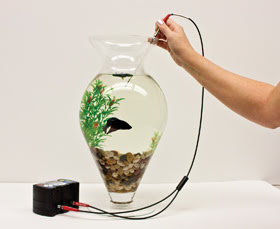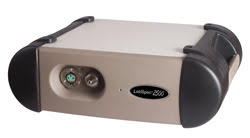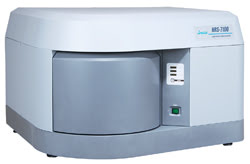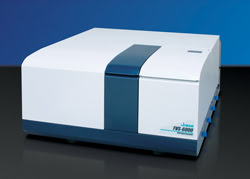Optical spectroscopy can be used to monitor
nearly everything with which we come into contact – food, water, air, chemicals
– as well as the state of our health and the health of our world. It can be
used in research labs and in industrial settings for quality assurance or in hospitals
for analysis and diagnosis.
Keeping in mind the broad range of applications and, indeed, of
spectroscopic instruments from which to choose, BioPhotonics reached out to major
players in the industry to gain some insight into where life sciences spectroscopy
stands today and where it is going in the future.

The NeoFox oxygen sensor system from Ocean Optics Inc. can be used to monitor fish respiration,
among other applications.
Q: What do you see as the next big thing in spectroscopy in general?
A: Rob Morris, director of marketing at Ocean Optics Inc. in Dunedin,
Fla.: There is some interesting work being done with detectors to make them even
smaller and less expensive but without sacrificing performance. Also, the idea of
patterning optical thin-film filters on active photo-detector substrates opens up
opportunities in solid-state spectral sensing, from more precise color detection
to enhanced multispectral imaging.
A: Dr. Brian Curtiss, co-founder and chief technology officer
at ASD Inc. in Boulder, Colo.: While there are some industries that typically have
in-house capabilities to fully develop a spectroscopic analytical solution, there
are others that don’t. I think companies that can provide the complete solution
– from instrumentations, software, installation and support to calibrations
… and wherever they are needed – will be the ones that really thrive.

LabSpec products from ASD Inc. were designed
for raw materials testing and process optimization on a wide selection of materials,
including pharmaceutical tablets, biomass analysis, and biofuels inspection and
analysis.
A: Dr. Richard A. Larsen, spectroscopy product manager at Jasco
Inc. in Easton, Md.: This is so hard to predict because there are so many exciting
things happening, even in a field as “mature” as spectroscopy. We do
see Raman spectroscopy being utilized for more and different sample analysis, as
well as vibration circular dichroism (VCD) finally securing a place among the “standard”
molecular spectroscopy techniques.

The NRS-5000/7000 Raman microscopy systems from Jasco Inc. are laser Raman spectrometers
for rapid acquisition of data with automated system control and minimal optical
adjustments.
Q: What do you see as the next big thing in spectroscopy for the
life sciences?
A: Morris: Ultrafast spectroscopy certainly is an area worth keeping
an eye on. But the next big thing in spectroscopy may actually not be a spectrometer
at all. There are newer detection technologies – advanced filter-based techniques,
for example – that may reshape how we think of spectroscopy. Although it’s
become almost a cliché to mention the Star Trek tricorder as an example of
science fiction edging closer to science fact, the reality is that what once seemed
fantastical is now firmly in the realm of possibility.
A: Curtiss: Near-infrared spectroscopy instrumentation has advanced
to the level that it provides life sciences companies more complete data on biologically
derived raw materials. These materials have been challenging to measure in the past
because they are chemically complicated and vary over time. Instrumentation solutions
need to be flexible due to the variable nature of the materials. Not only is NIR
getting better at performing measurements in the laboratory, but the instrumentation
necessary for in-process real-time measurements is now available. Given growing
interest in improving processes involving biologically derived raw materials, there
is a growing need for these types of analysis.
A: Larsen: We definitely see the potential for VCD spectroscopy
as securing a place for the life sciences analysis arena. To date, VCD has been
utilized only for the analysis of chiral compounds, but as more users embrace this
technology, we feel that future developments will increase and important discoveries
will be made with this instrument in conjunction with other spectroscopy techniques.

The FVS-6000 high-performance vibrational
circular dichroism (VCD) spectrometer from Jasco Inc. allows easy collection of
fingerprint VCD spectra. Jasco produces a number of products for life sciences research
efforts, including UV-VIS, Raman, Fourier transform infrared, fluorescence, circular
dichroism and VCD.
Q: What new and exciting spectroscopy advances are you seeing
coming out of R&D and university labs?
A: Morris: The great news is that it’s hard to keep up with
what’s going on at the university level. For example, there are researchers
working on ways to better measure the output of curing lights used in dentistry.
The technology is relatively familiar, but what’s exciting is these folks
have identified a need – the number of dental fillings that are not properly
cured – and built a business around it.
A: Curtiss: One study that has received a lot of attention was
conducted by a group of USDA [US Department of Agriculture] and Centers for Disease
Control and Prevention scientists on the tsetse fly, the host for African trypanosomiasis,
better known as sleeping sickness. This is a deadly disease for both livestock and
humans. The World Health Organization says that about 50,000 human deaths are reported
annually from this disease. Using near-infrared spectroscopy, the researchers
were able to determine the sex of the flies before they emerged from pupae stage.
By sorting the insects based on spectroscopic techniques, then releasing only the
sterilized males, they believe they can help control the spread of this disease.
Another example is how biofuel feedstocks for cellulosic ethanol are being derived
from nonedible plant parts like cornstalk and wood chips. Since these materials
are compositionally complex and highly variable, they present a real analytical
challenge. Ongoing research at the National Renewable Energy Research Laboratory
is focusing on these challenges, and near-infrared analysis is playing a large part
in the solutions.
A: Larsen: R&D and research labs are continually using established
spectroscopy instrumentation to push the boundaries of current capabilities for
molecular research. As these laboratories continue to require advances in the instrumentation
that they utilize, companies like Jasco will continue to innovate, design and manufacture
the spectroscopic tools required for research in various fields. Research continues
in materials analysis, nanomaterials, life sciences, semiconductors and chiral molecules,
just to name a few. The mission of every instrument manufacturer is to provide the
necessary tools and techniques to aid researchers in their quest for answers, no
matter the types of samples to be examined.
Q: How would you say the market has been in the past few years
for spectroscopy in general?
A: Morris: Like most companies, we experienced the effects of
a weakened economy in the US. But we’ve experienced the beginnings of a very
healthy rebound that suggests folks are much more bullish about their prospects
and still mindful that research leads to growth. Also, I’ve noticed that technologies
often associated with biotechnology and life sciences – Raman, for example
– seem particularly robust these days.
A: Curtiss: The market in general has survived very well through
the recession. From our perspective, we saw that the industrial segment shrank,
and the research segment actually strengthened enough so that there wasn’t
a significant drop in business overall. We saw this internationally, not just domestically.
The growth of the research segment appears largely to be due to stimulus funding
put into place both in the US and China.
A: Larsen: Naturally, the worldwide economic situation has slowed
some areas of growth, but areas involving materials analysis, nutriceuticals analysis,
solar and bio-energy products, consumer goods, food analysis and many other analysis
requirements continue to push the boundaries of utility for spectroscopy instrumentation.
Q: How would you say the market has been in the past few years
for life sciences spectroscopy?
A: Morris: To follow my thread from the prior question, the market
has been especially good in the life sciences. That seems to be where the most exciting
new developments are happening. In the US, stimulus money from the federal government
has helped, although it’s difficult to gauge its impact on our business. If
you think about the scientific developments that reach the mainstream media, they’re
almost always from the life sciences.
A: Curtiss: Again, we’re seeing a lot of funding coming
in, particularly from stimulus dollars. There is more focus on incoming raw material
inspection, and changing FDA requirements to evaluate materials are also driving
the industry.
A: Larsen: Continuously expanding as more and more users try to
unravel the answers to protein conformation, protein interactions and solving the
mysteries of cellular chemistry.
Q: Where do you think the market is going for spectroscopy in
general?
A: Morris: We are very optimistic, generally, that the US market
will continue its rebound. And certainly China and the Asia Pacific region are growing
tremendously. I don’t have a great feel for what new technologies might emerge
in spectroscopy in the next several years, but my sense is that speed and ease of
use will be major components of those technologies.
A: Curtiss: I think [we will see] significant growth beyond materials
inspection to materials analysis. It’s not enough to provide customers with
the means to collect spectroscopic data, you must also provide the software tools
and calibrations necessary to convert that data into actionable information. The
other market driver I see is the need to measure materials in real time, not just
sending samples off to a lab. NIR spectroscopy is well suited to quickly measure
relevant constituents either near-line or in process.
A: Larsen: I believe that the spectroscopy market will continue
to expand as the ordinary consumer requires better products, at lower prices, with
high-quality standards. One cannot solve these various requirements without the
use of spectroscopy instrumentation.
Q: Where do you think the market is going for life sciences spectroscopy?
A: Morris: Of course, our perspective is colored by where we see
opportunity for our core spectroscopy and fiber optic chemical sensing technologies.
Expansion of what we know as lab on a chip – typically associated with microfluidics
– to be a sort of wavelength-selective measuring device is certainly intriguing.
A: Curtiss: There are growing concerns over counterfeit pharmaceuticals.
I think there’s a bigger public health issue, certainly in developing countries.
A staggering percentage of drugs that get to patients in many developing countries
are counterfeit – in some countries, as high as 70 to 80 percent. It’s
appalling. This often makes treating the disease more difficult by making the disease-causing
organism more resistant to the actual drug. NIR quickly measures relevant ingredients,
including the active pharmaceutical ingredient, binders, colorants and excipients.
The measurement process occurs rapidly, usually within a second or two, without
tampering with the sample.
A: Larsen: This area will also continue to expand as researchers
try to solve worldwide problems related to AIDS and other viral diseases, degenerative
diseases such as Parkinson’s and Alzeimer’s as well as continued research
into cancer, diabetes and other “plagues” of humankind.
Q: What are the biggest challenges to new advances in spectroscopy,
especially for the life sciences?
A: Morris: I am oversimplifying this, but my observation is the
smaller, more nimble companies are often limited by resources, while the resource-rich
larger companies are often limited by bureaucracy. This has the effect of slowing
down development and discovery. Another issue is the role of [the US] government
in the life sciences. Funding is critical, of course, but there is also the issue
of the government working in a complementary fashion with private industry for the
benefit of all. Some would suggest that’s not always the case.
A: Curtiss: There’s not a lot of comfort level with NIR
spectroscopy because many life scientists did not learn NIR as a primary research
tool; thus, utilizing NIR spectroscopy can be intimidating for them. Also, with
every new application, there’s a very large effort that has to go into calibration
modeling. While there are some industries that typically have in-house capabilities
to fully develop a spectroscopic analytical solution, there are others that do not.
In life sciences, you have a particular challenge because the biologically derived
raw materials being analyzed are chemically complicated and can vary over time.
There is no uniform product for the materials so if you are manufacturing something,
whether it be pharmaceuticals or next-generation biofuels, you have a challenge
in creating a uniform product. So it is necessary to work with a company that provides
a complete solution through not just the instrumentation, software and hardware
that can accurately analyze the raw materials, but also through all of the customer
support to know the calibrations necessary to provide production models that take
all of those multivariant materials into consideration. It is only through this
complete approach that they will be able to predict product yield, establish better
product consistency and more tightly manage production processes.
A: Larsen: Trying to manufacture new instrumentation that is user-friendly
and less complicated so that users can obtain reliable answers without extensive
training. This will allow researchers, R&D and QA/QC personnel to concentrate
on the questions, instead of the instrument operations required to obtain the answers
to the questions posed by scientists.
Q: Lastly, which application areas would you say are thriving
today – and why?
A: Morris: In life sciences we observe a significant amount of
work in biomedical diagnostics. That’s no big surprise, of course, given that
the world faces many issues related to the quality of life around the planet. There
also seem to be many applications involving the use of lasers to stimulate fluorescent
markers and tags, for example, which require high-sensitivity detection technologies
such as Raman.
A: Curtiss: We’re seeing a huge interest in better understanding
of global climate, particularly the interaction between the Earth’s surface
and atmosphere as it relates to atmospheric CO2. A specific project with which ASD
is involved is finding ways to maximize soil carbon storage. Organic carbon plays
a major role in how well a cultivated field holds moisture, provides nutrients and
remains productive, so there’s some crossover interest into the agriculture
industry. The ideal goal being, of course, to grow healthier crops while helping
to offset greenhouse gas emissions from other sources.
A: Larsen: Protein analysis continues to thrive, as there are
numerous questions involved in protein interaction. No one tool can provide all
the answers to these questions, so the life sciences laboratory needs to continually
investigate a variety of instruments, each one of which can provide a small piece
of the puzzle. This includes previously underutilized techniques such as VCD and
Raman spectroscopy, as well as many others. No single instrument or technique can
provide all the answers, so all the available tools must be utilized to their fullest
extent.